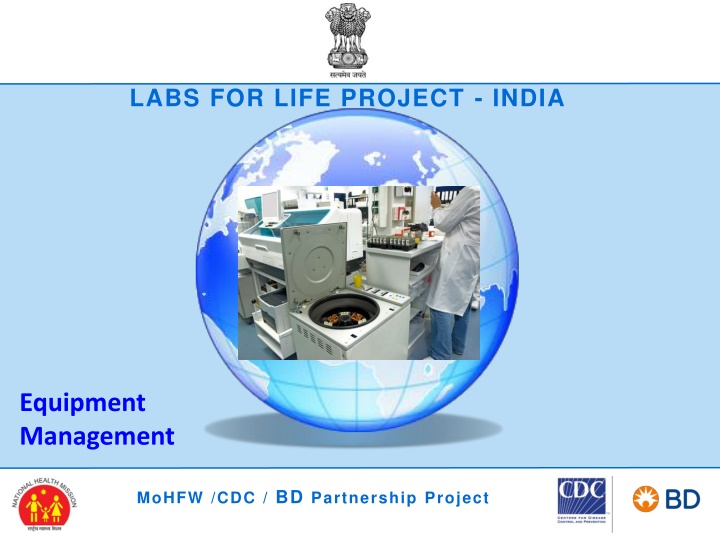Innovative Equipment Management for Improved Blood Testing in India
The LABS.FOR.LIFE.PROJECT in India, a collaboration between MoHFW, CDC, and BD, focuses on enhancing blood testing capabilities. Advanced equipment like Complete Blood Count Analyzers and different types of Cell Counters are used to analyze various blood components. The operation principles, such as Impedance, enable accurate cell differentiation and counting. The project aims to streamline healthcare processes and ensure precise test results for better patient care.
Download Presentation

Please find below an Image/Link to download the presentation.
The content on the website is provided AS IS for your information and personal use only. It may not be sold, licensed, or shared on other websites without obtaining consent from the author.If you encounter any issues during the download, it is possible that the publisher has removed the file from their server.
You are allowed to download the files provided on this website for personal or commercial use, subject to the condition that they are used lawfully. All files are the property of their respective owners.
The content on the website is provided AS IS for your information and personal use only. It may not be sold, licensed, or shared on other websites without obtaining consent from the author.
E N D
Presentation Transcript
LABS FOR LIFE PROJECT - INDIA Equipment Management MoHFW /CDC / BD Partnership Project
Complete Blood Count Analyzers These analyzers are used to count the number of different types of red and white blood cells, blood platelets, hemoglobin, and hematocrit levels in a blood sample. MoHFW /CDC / BD Partnership Project
Types of Cell Counters 3-Part Differential Cell Counters Provides neutrophils, lymphocytes and mononuclear cell counts Unable to distinguish between monocyte, eosinophils, and basophils. 5-Part Differential Cell Counters Able to determine granularity, diameter, and inner complexity of blood cells. Able to differentiate all 5 population of WBCs Some cell counters are able to detect and abnormal cell populations Erythrocytes Neutrophils Lymphocytes Basophils Eosinophils Monocytes Platelets MoHFW /CDC / BD Partnership Project
Principle of operation of Cell counter Impedance Principle: Cells are non-conductive Electrical resistance caused by cells is proportional to their volume /size. Various blood cells could be differentiated based on this principle MoHFW /CDC / BD Partnership Project
Principle of operation of Cell counter Diluted blood is passed between two electrodes through an aperture Impedance changes as a cell passes through is monitored. A lytic reagent is added to the blood solution to selectively lyse the red cells (RBCs) leaving only white cells (WBCs), and platelets intact. The platelet count is easily separated from the WBC count by the smaller impedance spikes they produce in the detector due to their lower cell volumes Impedance principle is used for CBCs and three-part WBC differentials MoHFW /CDC / BD Partnership Project
The Impedance principle A red cell passes through RBC aperture Red Blood Cell Sensing Zone Oscilloscope Oscilloscope
The Impedance principle A red cell passes through RBC aperture Red Blood Cell Sensing Zone Oscilloscope Oscilloscope
The Impedance principle A White cell passes through WBC aperture Neutrophil Oscilloscope Sensing Zone Oscilloscope
The Impedance principle A White cell passes through WBC aperture Neutrophil Oscilloscope Sensing Zone Oscilloscope
The Impedance principle A White cell passes through WBC aperture Neutrophil Oscilloscope Sensing Zone Oscilloscope
Applying Thresholds to separate Plt from RBC 20 fl 2 fl Base line Platelets RBC of various sizes
3-Part Differential Histogrm Lymphocyte Monocyte Granulocyte 256 channel high resolution WBC histogram display cell population data between 35 and 450 fl
Coulter WBC histogram Monocytes Lymphocytes Neutrophils Basophils Eosinophils
Principle of operation of 5-part Differential Counters Besides using impedance principle, 5-part differential cell counters employ flowcytometric principles Through hydrodynamic focusing cells are passed through an aperture in single file Cells are subjected to laser beam which assists in: Identifying granularity of the cells Identify nuclear structure Based on size, granularity and nuclear structure, cells are separated in 3- dimentional space All five types of WBCs are identified based on their typical position in 3-dimentional space MoHFW /CDC / BD Partnership Project
Hemoglobin Measurement Signal Processor WBC Bath ADC HGB Lamp Derivation Absorbance= log 10 ( VR / Vs ) Where VR = Reference voltage Vs = Sample voltage HGB Sensor & PRE-AMP Sample MoHFW /CDC / BD Partnership Project
Cell counter Key components Tube cap piercer Typical report Single Sample port Tube rack station MoHFW /CDC / BD Partnership Project
Maintenance of Cell Counters Follow your manufacturer s instructions manual for specific maintenance needs of your analyzer instructions given here are only indicative Always use PPE while performing maintenance Keep the cell counter surface and surroundings clean using 10% bleach. Most of computerized cell counters have computer-controlled maintenance menu. Users must be familiar with these Inspect the bottom of washing head for salt build up should be wiped off with a damp cloth or wiper Check tubing system and look for any liquid leakage. If you experience leakage, contact authorized technician. Perform daily start-up and shut-down cycles these cycles are important for auto- cleaning of tubing and apertures and hence in reducing blank values Check reagent status and change if required Empty waste container before starting the day Waste contains human origin substances representing biohazard. Neutralization of biohazard waste: Put 2 ml per liter of hypochlorite solution into the waste. Close the cap and Shake the container., after 1 hour you can dispose of the Waste liquid into the drain. MoHFW /CDC / BD Partnership Project
Example of Weekly Maintenance of Cell Counters Follow your manufacturer s instructions manual for specific maintenance needs of your analyzer instructions given here are only indicative Cleaning of Probe washing head: Salt build-up on the lower surface of wash head may cause malfunction during operation leading to carryover between samples. Use a soft cloth or wiper dampened with water to clean this area. Inspect aspiration / dilution syringes for leaks or salt buildup Clean sample auto-loader station and track Probe wash head MoHFW /CDC / BD Partnership Project
Calibration of cell counters Automated hematology analyzers shall be calibrated using calibrator provided by manufacturer: Controls shall not be used for calibration. Hematology calibrators have short expiry and very short open vial stability. Ensure traceability of calibrators to ICSH. Some 3 part equipment calibrators have a defined Uncertainty of Measurement and give a range for the target. Calibrators with more accurate values give a single, equipment specific target value. It is important to ensure adequate equipment performance in terms of precision, background values and carry over values before performing CBC analyzer calibrations. Both closed and open modes should be calibrated whenever 2 modes are available. Calibration should be followed by verification QC to verify acceptable performance MoHFW /CDC / BD Partnership Project























